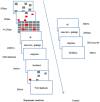Differential Impact of Visuospatial Working Memory on Rule-based and Information-integration Category Learning
- PMID: 28439250
- PMCID: PMC5384164
- DOI: 10.3389/fpsyg.2017.00530
Differential Impact of Visuospatial Working Memory on Rule-based and Information-integration Category Learning
Abstract
Previous studies have indicated that the category learning system is a mechanism with multiple processing systems, and that working memory has different effects on category learning. But how does visuospatial working memory affect perceptual category learning? As there is no definite answer to this question, we conducted three experiments. In Experiment 1, the dual-task paradigm with sequential presentation was adopted to investigate the influence of visuospatial working memory on rule-based and information-integration category learning. The results showed that visuospatial working memory interferes with rule-based but not information-integration category learning. In Experiment 2, the dual-task paradigm with simultaneous presentation was used, in which the categorization task was integrated into the visuospatial working memory task. The results indicated that visuospatial working memory affects information-integration category learning but not rule-based category learning. In Experiment 3, the dual-task paradigm with simultaneous presentation was employed, in which visuospatial working memory was integrated into the category learning task. The results revealed that visuospatial working memory interferes with both rule-based and information-integration category learning. Through these three experiments, we found that, regarding the rule-based category learning, working memory load is the main mechanism by which visuospatial working memory influences the discovery of the category rules. In addition, regarding the information-integration category learning, visual resources mainly operates on the category representation.
Keywords: dual-task paradigm; executive function; information-integration category structure; rule-based category structure; visual processing; visuospatial working memory.
Figures







Similar articles
-
The role of visuospatial and verbal working memory in perceptual category learning.Mem Cognit. 2007 Sep;35(6):1380-98. doi: 10.3758/bf03193609. Mem Cognit. 2007. PMID: 18035635
-
Dual-task interference in perceptual category learning.Mem Cognit. 2006 Mar;34(2):387-98. doi: 10.3758/bf03193416. Mem Cognit. 2006. PMID: 16752602
-
The Effect of Concurrent Auditory Working Memory Task in Auditory Category Learning.Behav Sci (Basel). 2025 Mar 31;15(4):440. doi: 10.3390/bs15040440. Behav Sci (Basel). 2025. PMID: 40282062 Free PMC article.
-
The neurobiology of category learning.Behav Cogn Neurosci Rev. 2004 Jun;3(2):101-13. doi: 10.1177/1534582304270782. Behav Cogn Neurosci Rev. 2004. PMID: 15537987 Review.
-
Human category learning.Annu Rev Psychol. 2005;56:149-78. doi: 10.1146/annurev.psych.56.091103.070217. Annu Rev Psychol. 2005. PMID: 15709932 Review.
References
-
- Baddeley A. D., Logie R. H. (1999). “Working memory: the multiple-component model,” in Models of Working Memory: Mechanisms of Active Maintenance and Executive Control eds Miyake A., Shah P. (New York, NY: Cambridge University Press; ) 28–61.
LinkOut - more resources
Full Text Sources
Other Literature Sources
Research Materials

